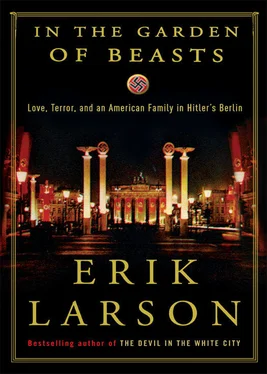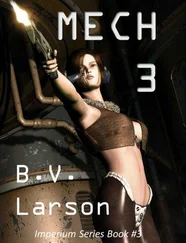What Martha also found compelling about Diels was the fact that everyone else was afraid of him. He was often referred to as the “Prince of Darkness,” and, as Martha learned, he did not mind at all. “He took a vicious joy in his Mephistophelian manners and always wanted to create a hush by his melodramatic entrance.”
Diels early on had allied himself closely with Göring, and when Hitler became chancellor, Göring, as the new Prussian minister of the interior, rewarded Diels’s loyalty by making him head of the newly created Gestapo, despite the fact that Diels was not a member of the Nazi Party. Göring installed the agency in an old art school at Prinz-Albrecht-Strasse 8, roughly two blocks from the U.S. consulate on Bellevuestrasse. By the time of the Dodds’ arrival in Berlin, the Gestapo had become a terrifying presence, though it was hardly the all-knowing, all-seeing entity that people imagined it to be. Its roster of employees was “remarkably small,” according to historian Robert Gellately. He cites the example of the agency’s Düsseldorf branch, one of the few for which detailed records survive. It had 291 employees responsible for a territory encompassing four million people. Its agents, or “specialists,” were not the sociopaths of popular depiction, Gellately found. “Most of them were neither crazed, demented, nor superhuman, but terribly ordinary.”
The Gestapo enhanced its dark image by keeping its operations and its sources of information secret. Out of the blue people received postcards requesting that they appear for questioning. These were uniquely terrifying. Despite their prosaic form, such summonses could not be discarded or ignored. They put citizens in the position of having to turn themselves in at that most terrifying of buildings to respond to charges of offenses about which they likely had no inkling, with the potential—often imagined but in many cases quite real—that by day’s end they would find themselves in a concentration camp, under “protective custody.” It was this accumulation of unknowns that made the Gestapo so fearsome. “One can evade a danger that one recognizes,” wrote historian Friedrich Zipfel, “but a police working in the dark becomes uncanny. Nowhere does one feel safe from it. While not omnipresent, it could appear, search, arrest. The worried citizen no longer knows whom he ought to trust.”
Yet under Diels the Gestapo played a complex role. In the weeks following Hitler’s appointment as chancellor, Diels’s Gestapo acted as a curb against a wave of violence by the SA, during which Storm Troopers dragged thousands of victims to their makeshift prisons. Diels led raids to close them and found prisoners in appalling conditions, beaten and garishly bruised, limbs broken, near starvation, “like a mass of inanimate clay,” he wrote, “absurd puppets with lifeless eyes, burning with fever, their bodies sagging.”
Martha’s father liked Diels. To his surprise, he found the Gestapo chief to be a helpful intermediary for extracting foreign nationals and others from concentration camps and for exerting pressure on police authorities outside Berlin to find and punish the SA men responsible for attacks against Americans.
Diels was no saint, however. During his tenure as chief, thousands of men and women were arrested, many tortured, some murdered. On Diels’s watch, for example, a German communist named Ernst Thälmann was imprisoned and interrogated at Gestapo headquarters. Thälmann left a vivid account. “They ordered me to take off my pants and then two men grabbed me by the back of the neck and placed me across a footstool. A uniformed Gestapo officer with a whip of hippopotamus hide in his hand then beat my buttocks with measured strokes. Driven wild with pain I repeatedly screamed at the top of my voice.”
In Diels’s view, violence and terror were valuable tools for the preservation of political power. During a gathering of foreign correspondents at Putzi Hanfstaengl’s home, Diels told the reporters, “The value of the SA and the SS, seen from my viewpoint of inspector-general responsible for the suppression of subversive tendencies and activities, lies in the fact that they spread terror. That is a wholesome thing.”
MARTHA AND DIELS TOOK walks together in the Tiergarten, which was fast becoming recognized as the one place in central Berlin where a person could feel at ease. Martha especially loved strolling through the park in autumn, amid what she termed “the golden death of the Tiergarten.” They went to movies and nightclubs and drove for hours through the countryside. That they became lovers seems likely, despite the fact that both were married, Martha in technical terms only, Diels in name only, given his penchant for adultery. Martha loved being known as the woman who slept with the devil—and that she did sleep with him seems beyond doubt, though it is equally likely that Dodd, like naive fathers everywhere and in every time, had no idea. Messersmith suspected it, and so did Raymond Geist, his second in command. Geist complained to Wilbur Carr, head of consular services in Washington, that Martha was a “most indiscreet” young lady who had been “in the habit of constantly going about at night with the head of the Nazi Secret Police, a married man.” Geist himself had heard her call Diels, in public, a variety of affectionate names, among them “dearie.”
The more Martha came to know Diels, the more she saw that he too was afraid. He felt “he was constantly facing the muzzle of a gun,” she wrote. He was most at ease during their drives, when no one could overhear their conversations or monitor their behavior. They would stop and walk through forests and have coffee in remote, little-known cafés. He told her stories of how everyone in the Nazi hierarchy distrusted everyone else, how Göring and Goebbels loathed each other and spied on each other, how both spied on Diels, and how Diels and his men spied on them in turn.
It was through Diels that she began for the first time to temper her idealistic view of the Nazi revolution. “There began to appear before my romantic eyes… a vast and complicated network of espionage, terror, sadism and hate, from which no one, official or private, could escape.”
Not even Diels, as events soon would demonstrate.
CHAPTER 14
The Death of Boris
There was still another lover in Martha’s life, the most important of all, a doomed Russian who would shape the rest of her life.
She first caught a glimpse of him in mid-September 1933 at one of the many parties Sigrid Schultz held at her apartment, where she lived with her mother and her two dogs. Schultz typically served sandwiches, baked beans, and sausages prepared by her mother and provided a lot of beer, wine, and liquor, which tended to cause even Nazi guests to shed doctrine in favor of fun and gossip. In the midst of a conversation, Martha happened to glance across the room and saw a tall, good-looking man at the center of a group of correspondents. He was not handsome in a conventional sense but very attractive—maybe thirty, short blond-brown hair, strikingly luminous eyes, and an easy, fluid manner. He moved his hands as he spoke, and Martha saw that he had long and supple fingers. “He had an unusual mouth, and upper lip,” recalled one of Martha’s friends, Agnes Knickerbocker, wife of correspondent H. R. “Knick” Knickerbocker. “I can’t describe it other than to say that it could go from sternness to laughter in an exploding split second.”
As Martha watched him, he turned and looked at her. She held his gaze a few moments, then looked away and became involved in other conversations. (In a later unpublished account she recalled minute details of this moment and others to follow.) He turned away as well—but when the morning came and the night distilled to its essential elements, this meeting of glances was the thing that both remembered.
Читать дальше












